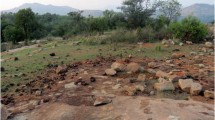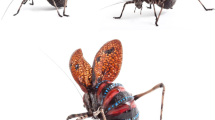Abstract
Escape latency theory models the tradeoff between maintaining crypsis by remaining immobile near an immobile predator versus moving to flee or engage in fitness-enhancing activities. The model predicts that latency to flee increases as cost of fleeing increases and decreases as cost of remaining immobile increases. As predation risk increases, cost of fleeing, primarily due to abandoning crypsis due to immobility, decreases. Predictions have been tested for few risks and a single cost of immobility factor in only two species of active foragers. To gauge the breadth of applicability of the model, we tested effects of four risk factors and two cost of immobility factors in ambush-foraging phrynosomatid lizards, which we selected for testing because foraging mode strongly affects many aspects of ecology and behavior of lizards. Latency to flee decreased as standing distance (predator–prey distance before fleeing) decreased, predator approach speed increased, directness of approach increased, and predator persistence increased. Latency to move was shorter in the presence of food and shorter for males in the presence of females. Lizards often moved toward food or females instead of fleeing. Latency was affected as predicted by all risk and by cost of remaining immobile factors. Our findings agree with previous results for the same four risk factors and the foraging cost of immobility. That social cost of immobility affects latency as predicted is a novel finding. The model is robust, applying to ecologically diverse prey and to a wide range of factors affecting costs of fleeing and of immobility.



Similar content being viewed by others
References
Anderson RA, Karasov WH (1981) Contrasts in energy intake and expenditure in sit-and-wait and widely foraging lizards. Oecologia 49:67–72
Blumstein DT (2003) Flight-initiation distance in birds is dependent on intruder starting distance. J Wildlife Manag 67:852–857
Bulova SJ (1994) Ecological correlates of population and individual variation in antipredator behavior of two species of desert lizards. Copeia 1994:980–992
Chamaillè-Jammes S, Blumstein DT (2012) A case for quantile regression behavoral ecology: getting more out of flight initiation distance data. Behav Ecol Sociobiol 66:985–992
Cooper WE Jr (1995) Foraging mode, prey chemical discrimination, and phylogeny in lizards. Anim Behav 50:973–985
Cooper WE Jr (1997) Correlated evolution of prey chemical discrimination with foraging, lingual morphology, and vomeronasal chemoreceptor abundance in lizards. Behav Ecol Sociobiol 41:257–265
Cooper WE Jr (1999) Tradeoffs between courtship, fighting, and antipredatory behavior by a lizard, Eumeces laticeps. Behav Ecol Sociobiol 47:54–59
Cooper WE Jr (2000) Tradeoffs between predation risk and feeding in a lizard, the broad-headed skink (Eumeces laticeps). Behaviour 137:1175–1189
Cooper WE Jr (2005) The foraging mode controversy: both continuous variation and clustering of foraging movements occur. J Zool 267:179–190
Cooper WE Jr (2007a) Lizard chemical senses, chemosensory behavior, and foraging mode. In: Reilly SM, McBrayer LD, Miles DB (eds) Lizard ecology: the evolutionary consequences of foraging mode. Cambridge University Press, Cambridge, pp 237–270
Cooper WE Jr (2007b) Foraging modes as suites of coadapted movement traits. J Zool 272:45–56
Cooper WE Jr (2009a) Fleeing and hiding under simultaneous risks and costs. Behav Ecol 20:665–671
Cooper WE Jr (2009b) Theory successfully predicts hiding time: new data for the lizard Sceloporus virgatus and a review. Behav Ecol 20:585–592
Cooper WE Jr (2009c) Optimal escape theory predicts escape behaviors beyond flight initiation distance: risk assessment and escape by striped plateau lizards Sceloporus virgatus. Curr Zool 55:123–131
Cooper WE Jr (2009d) Flight initiation distance decreases during social activity in lizards (Sceloporus virgatus). Behav Ecol Sociobiol 63:1765–1771
Cooper WE Jr (2010a) Economic escape. In: Breed MD, Moore J (eds) Encyclopedia of animal behavior, vol. 1. Academic Press, London, pp 588–595
Cooper WE Jr (2010b) Pursuit deterrence varies with predation risks affecting escape behaviour in the lizard Callisaurus draconoides. Anim Behav 80:249–256
Cooper WE Jr, Avalos A (2010) Predation risk, escape and refuge use by mountain spiny lizards (Sceloporus jarrovii). Amphibia-Reptilia 31:363–373
Cooper WE Jr, Frederick WG (2007a) Optimal flight initiation distance. J Theor Biol 244:59–67
Cooper WE Jr, Frederick WG (2007b) Optimal time to emerge from refuge. Biol J Linn Soc 91:375–382
Cooper WE Jr, Frederick WG (2010) Predator lethality, optimal escape behavior, and autotomy. Behav Ecol 21:91–96
Cooper WE Jr, Sherbrooke WC (2010) Plesiomorphic escape decisions in cryptic horned lizards (Phrynosoma) having highly derived antipredatory defenses. Ethology 116:920–928
Cooper WE Jr, Vitt LJ (2002) Distribution, extent, and evolution of plant consumption by lizards. J Zool 257:487–517
Cooper WE Jr, Pérez-Mellado V, Baird T, Baird TA, Caldwell JP, Vitt LJ (2003) Effects of risk, cost, and their interaction on optimal escape by nonrefuging Bonaire whiptail lizards, Cnemidophorus murinus. Behav Ecol 14:288–293
Cooper WE Jr, Perez-Mellado V, Hawlena D (2006) Magnitude of food reward affects escape behavior and acceptable risk in Balearic lizards, Podarcis lilfordi. Behav Ecol 17:554–559
Cooper WE Jr, Hawlena D, Pérez-Mellado V (2009) Effects of predation risk factors on escape behavior by Balearic lizards (Podarcis lilfordi) in relation to optimal escape theory. Amphibia-Reptilia 30:99–110
Cooper WE Jr, Hawlena D, Pérez-Mellado V (2010) Influence of risk on hiding time by Balearic lizards (Podarcis lilfordi): predator approach speed, directness, persistence, and proximity. Herpetologica 66:131–141
Cooper WE Jr, López P, Martín J, Pérez-Mellado V (2012) Latency to flee from an immobile predator: effects of risk and cost of immobility for the prey. Behav Ecol 23:790–797
Huey RB, Pianka ER (1981) Ecological consequences of foraging mode. Ecology 62:991–999
Martín J, López P (1999) When to come out from a refuge: risk-sensitive and state-dependent decisions in an alpine lizard. Behav Ecol 10:487–492
Martín J, López P (2001) Repeated predatory attacks and multiple decisions to come out of refuge in an alpine lizard. Behav Ecol 12:386–389
Martín J, López P, Cooper WE Jr (2003a) Loss of mating opportunities influences refuge use in the Iberian rock lizard, Lacerta monticola. Behav Ecol Sociobiol 54:505–510
Martín J, López P, Cooper WE Jr (2003b) When to come out from a refuge: balancing predation risk and foraging opportunities in an alpine lizard. Ethology 109:77–87
Martín J, Luque-Larena JJ, López P (2009) When to run from an ambush predator: balancing crypsis benefits with costs of fleeing in lizards. Anim Behav 78:1011–1018
Perry G (1999) The evolution of search modes: ecological versus phylogenetic perspectives. Amer Nat 153:99–109
Polo V, López P, Martín J (2005) Balancing the thermal costs and benefits of refuge use to cope with persistent attacks from predators: a model and an experiment with an alpine lizard. Evol Ecol Res 7:23–35
Reilly SM, McBrayer LB, Miles DB (2007) Lizard ecology: the evolutionary consequences of foraging mode. Cambridge University Press, New York, p 531
Rosenthal R, Rubin DB (2003) r equivalent: a simple effect size indicator. Psychol Method 8:492–496
Sokal RR, Rohlf FJ (1995) Biometry: The principles and practice of statistics in biological research, 3rd edn. Freeman, New York
Stankowich T, Blumstein DT (2005) Fear in animals: a meta-analysis and review of risk assessment. Proc R Soc Lond B 272:2627–2634
Stankowich T, Coss RG (2007) Effects of risk assessment, predator behavior, and habitat on escape behavior in Columbian black-tailed deer. Behav Ecol 18:358–367
Tullberg BS, Merilaita S, Wiklund S (2005) Aposematism and crypsis combined as a result of distance: functional versatility of the colour pattern in the swallowtail butterfly larva. Proc R Soc Lond B 272:1315–1321
Vitt LJ, Pianka ER, Cooper WE Jr, Schwenk K (2003) History and the global ecology of squamate reptiles. Am Nat 162:44–60
Wright SP (1992) Adjusted p-values for simultaneous inference. Biometrics 48:1005–1013
Ydenberg RC, Dill LM (1986) The economics of fleeing from predators. Adv Stud Behav 16:229–249
Author information
Authors and Affiliations
Corresponding author
Additional information
Communicated by S. J. Downes
Rights and permissions
About this article
Cite this article
Cooper, W.E., Sherbrooke, W.C. Risk and cost of immobility in the presence of an immobile predator. Behav Ecol Sociobiol 67, 583–592 (2013). https://doi.org/10.1007/s00265-013-1477-x
Received:
Revised:
Accepted:
Published:
Issue Date:
DOI: https://doi.org/10.1007/s00265-013-1477-x




